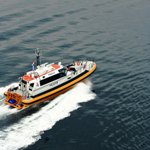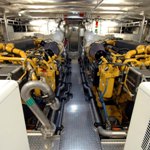Cat Powers Dutch Pilot Boats
 Delivered in March 2010 to Loodswezen, the Dutch pilot organisation, the 22m all-weather fast pilot boat Aquila, is powered by twin Cat C32 ACERT engines, rated at 970 bkW at 2100 rpm. Built by Kvichak Marine Industries from Seattle, Washington, USA, and designed by naval architecture firm Camarc Design in the UK, which had also designed Loodswezen’s current high speed pilot boats, two more are underway.
Delivered in March 2010 to Loodswezen, the Dutch pilot organisation, the 22m all-weather fast pilot boat Aquila, is powered by twin Cat C32 ACERT engines, rated at 970 bkW at 2100 rpm. Built by Kvichak Marine Industries from Seattle, Washington, USA, and designed by naval architecture firm Camarc Design in the UK, which had also designed Loodswezen’s current high speed pilot boats, two more are underway.
Loodswezen has two identical boats on the way: the Draco in May 2010 and the Orion in June 2010. All three boats will rely on the proven reliability and low environmental impact of Cat C32 ACERT engines. Certified with an EPA (US Environmental Protection Agency) Tier 2-compliant ‘B’ heavy duty-rating, the C32 ACERT engines are manufactured in Caterpillar’s Marine Center of Excellence (MCOE) in Greenville, South Carolina, USA and delivered by N C Power Systems, the local Cat dealer for the Pacific Northwest. Improved performance from Cat engines not only means more power overall, but also better acceleration, more reserve power and rated power available at a wider speed range, all while operating virtually smoke free. These engines allow for excellent maneuverability and a top speed of ~28.5 knots fully loaded, which match the performance of the rest of the pilot boats in Loodswezen’s fleet without sacrificing environmental consciousness.
 The Aquila is equipped with an exhaust after-treatment system consisting of a Selective Catalytic Reduction system (SCR) and a Diesel Particulate Filter system (DPF). The SCR system injects a urea based mixture downstream of the engine exhaust outlets into the dry exhaust piping, which is combined with nitrogen oxide (NOx) emissions with the aid of a catalyst. The DPF collects the unburnt soot and with the presence of another catalyst converts the carbon monoxide (CO), hydrocarbons (HC), and particulate soot into carbon dioxide (CO2) and water (H20). Normal running exhaust temperatures are high enough to achieve an almost complete burn of these captured soot particles. The emission performance will have a reduction of 98 percent of particulate matter and 60% reduction of NOx, fulfilling all new requirements by IMO and EU guidelines.
The Aquila is equipped with an exhaust after-treatment system consisting of a Selective Catalytic Reduction system (SCR) and a Diesel Particulate Filter system (DPF). The SCR system injects a urea based mixture downstream of the engine exhaust outlets into the dry exhaust piping, which is combined with nitrogen oxide (NOx) emissions with the aid of a catalyst. The DPF collects the unburnt soot and with the presence of another catalyst converts the carbon monoxide (CO), hydrocarbons (HC), and particulate soot into carbon dioxide (CO2) and water (H20). Normal running exhaust temperatures are high enough to achieve an almost complete burn of these captured soot particles. The emission performance will have a reduction of 98 percent of particulate matter and 60% reduction of NOx, fulfilling all new requirements by IMO and EU guidelines.
As R.M. Eichelsheim, President of Loodswezen, explained, “This boat will give Loodswezen a head start on future emissions requirements. Most importantly it will allow Loodswezen to renew their fleet while still greatly reducing overall fleet emissions. This kind of successful new boat program benefits all parties, protects the environment, and sets the standard for future marine projects.”






